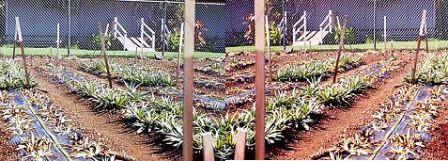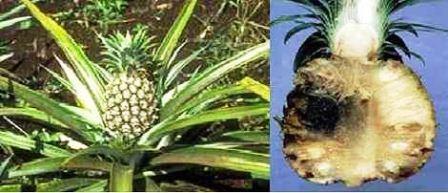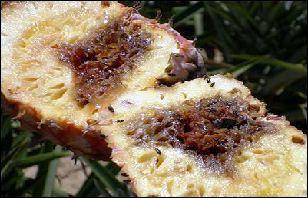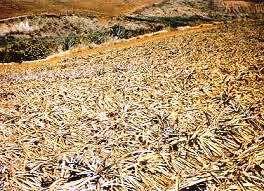Pineapple: Diseases and Symptoms
Pineapple: Diseases and Symptoms
- Fungi associated diseases
- Phytophthora heart (top) rot
- Phytophthora root rot
- Base (butt) rot
- Fruitlet core rot (green eye)
- Fusariosis
- Green fruit rot
- Inter fruitlet corking
- Leathery pocket
- Water blister
- White leaf spot
- Fruit rot by yeast and candida species
- Nematodes associated diseases
- Bacteria and phytoplasmas associated diseases
- Virus associated diseases
- IPM for Pineapple
Fungi associated diseases
Phytophthora heart (top) rot
Damage symptoms Plants of all ages are attacked, but three to four month old crown plantings are most susceptible.
Plants of all ages are attacked, but three to four month old crown plantings are most susceptible. - Fruiting plants or suckers on ratoon plants may be affected.
- The colour of the heart leaves changes to yellow or light coppery brown. Later, the heart leaves wilt (causing the leaf edges to roll under), turn brown and eventually die.
- Once symptoms become visible, young leaves are easily pulled from the plant, and the basal white leaf tissue at the base of the leaves becomes water-soaked and rotten with a foul smell due to the invasion of secondary organisms. The growing point of the stem becomes yellowish-brown with a dark line between healthy and diseased areas.
- Chlamydospores of the two species are the primary inoculum and they can survive in the soil or in infected plant debris for several years.
- They germinate directly to produce hyphae that are able to infect roots and young leaf and stem tissue, or indirectly to produce sporangia.
- Phytophthora pathogens are soil inhabitants and require water for spore production and infection. As free water is required for producing sporangia and releasing motile zoospores, infection and disease development is exacerbated in soils with restricted drainage.
Phytophthora root rot
Damage symptoms The symptoms above ground are similar to those caused by nematodes, mealy bug wilt and low levels of soil oxygen and are not diagnostic. Leaves change in colour from a healthy green through various shades of red and yellow.
The symptoms above ground are similar to those caused by nematodes, mealy bug wilt and low levels of soil oxygen and are not diagnostic. Leaves change in colour from a healthy green through various shades of red and yellow. - Leaf tips and margins eventually become necrotic, the root system is dead and plants can easily be pulled from the ground.
- Fruits from infected plants colour prematurely become small and unmarketable. If symptoms are recognized early and control measures are taken plants can recover. If roots are killed right back to the stem, they often fail to regenerate
- Losses can be severe in poorly drained fields. Plants on even relatively well-drained soils can be affected during prolonged wet weather.
- Losses from root rot can be serious in high rainfall areas where prolonged rains extend into the winter months.
- The disease can eliminate the ratoon crop.
- Rough leaf varieties and some low acid hybrids are more susceptible than Smooth Cayenne.
Base (butt) rot
Damage symptoms Symptoms are seen only on crowns, slips and suckers before or immediately after planting. A grey to black rot of the soft butt tissue develops, leaving stringy fibers and a cavity at the base of the stem. If affected material is planted, partial decay of the butt severely reduces plant growth.
Symptoms are seen only on crowns, slips and suckers before or immediately after planting. A grey to black rot of the soft butt tissue develops, leaving stringy fibers and a cavity at the base of the stem. If affected material is planted, partial decay of the butt severely reduces plant growth. - When butt decay is severe, plants fail to establish, wilt rapidly and leaf tissue dies. Unlike Phytophthora heart rot, the young leaves remain firmly attached to the top of the stem. Infected plants can easily be broken off at ground level.
- The fungus is important in the breakdown of pineapple residues after cropping and survives as chlamydospores in soil and decaying pineapple residues.
- The fungus commonly infects plants through fresh wounds occurring where the planting material has been detached from the parent plant and destroys the soft tissue at the base of the stem.
- Material removed during showery weather and stored in heaps is particularly prone to infection. Tops (crowns) used for planting are particularly susceptible
- Conidia are produced under conditions of high humidity and can be dispersed by wind. Losses of planting material and plantings from diseased material can be severe at times
Fruitlet core rot (green eye)
Damage symptoms This is an internal fruit disease. Smooth Cayenne fruits do not usually show any external symptoms. However, fruit of the rough-leaf (Mauritius) may produce fruitlets that fail to colour – a condition often referred to as „green eye‟.
This is an internal fruit disease. Smooth Cayenne fruits do not usually show any external symptoms. However, fruit of the rough-leaf (Mauritius) may produce fruitlets that fail to colour – a condition often referred to as „green eye‟. - Severely affected fruitlets may become brown and sunken as the fruit ripens. Internal symptoms consist of a browning of the centre of the fruitlets starting below the floral cavity and sometimes extending to the core. The browning, which remains quite firm, varies in size from a speck to complete discolouration of one or more fruitlets
- Penicillium funiculosum infects the developing fruit at some stage between initiation and open flower. Infection is favoured by cool temperatures (16–20oC) during the five weeks after flower initiation, during which time the fungus builds up in leaf hairs damaged by mites. Similar cool temperatures are required for infection from about 10–15 weeks after flower induction.
- Symptoms of fruit let core rot on a fruit cylinder in damaged leaf hairs. Fusarium guttiforme enters the fruit through open flowers or injury sites. The risk of disease caused by this fungus is higher when flowers are initiated and fruit mature under warm conditions.
Fusariosis
Damage symptoms It is sporadic and affects all parts of the pineapple plant but is most conspicuous and damaging on fruit.
It is sporadic and affects all parts of the pineapple plant but is most conspicuous and damaging on fruit. - Fruits exhibit stem rosetting and curvature of the plant because portions of the stem are girdled or killed.
- Rough leaf pineapple cultivars are more susceptible than smooth-leaf varieties
- Infections of the inflorescence and fruit occur primarily via injuries caused by insects, particularly the pineapple fruit caterpillar (Thecla basilides) and by infected planting materials
Green fruit rot
Damage symptoms- Green fruit in contact with the soil are liable to be infected.
- A water-soaked rot develops internally behind affected fruit lets with no external symptoms, As the disease progresses, a general, water-soaked rot of green fruit with a distinct brown margin develops in green fruit.
- The pathogen lives in the soil and requires free water for spore production and fruit infection. Ratoon crop fruit lying close to or touching soil are most affected.
- Spores may be splashed by rain on to fruit near the ground
Inter fruitlet corking
Damage symptoms- Fruits affected by inter fruitlet corking often show shiny patches on the shell early in their development, where the trichomes (hairs) have been removed by mite feeding.
- Externally, corky tissue develops on the skin between the fruitlets, but usually only „patches‟ of eyes are affected.
- Fine, transverse cracks may also develop on the sepals and bracts.
- In moderate to severe cases, corkiness surrounding fruitlets prevents their development and one side of the fruit will be malformed.
Leathery pocket
Damage symptoms- Fruits do not usually show any external symptoms. Internally, the formation of corky tissue on the walls of the fruitlets makes them leathery and brown.
- See fruitlet core rot. Leathery pocket occurs sporadically. Penicillium funiculosum infects the developing fruit at some stage between initiation and open flower.
- Infection is favoured by cool temperatures (16–200C) during the five weeks after flower initiation, during which time the fungus builds up in leaf hairs damaged by mites.
- Similar cool temperatures are required for infection from about 10–15 weeks after flower induction
Water blister
Damage symptoms Symptoms include water blister, which is also referred to as black rot or soft rot. This causes a soft, watery rot of the fruit flesh and makes the overlying skin glassy, water-soaked and brittle.
Symptoms include water blister, which is also referred to as black rot or soft rot. This causes a soft, watery rot of the fruit flesh and makes the overlying skin glassy, water-soaked and brittle. - The skin, flesh and core disintegrate and the fruit leaks through the shell. In advanced cases, this leaves a fruit shell containing only a few black fibres. This shell collapses under the slightest pressure.
- Infection occurs through shell bruises and growth cracks but mainly through the broken fruit stalks.
- The disease is most active in warm, wet weather and is most severe from January to April, when the summer crop is harvested. (The correlation between rainfall before harvest and disease after harvest has resulted in the name „water blister‟).
- When fresh fruits are marketed with the crowns left on, this eliminates a major point of entry for the fungus.
White leaf spot
Damage symptoms- The first symptom is a small, brown spot on the leaf, usually where the leaf margin has been rubbed by another leaf during strong winds.
- These spots lengthen rapidly during wet weather. During prolonged wet periods, spots may reach more than 20 cm in length and spread to the leaf tip.
- Fine weather rapidly dries the affected area leaving cream coloured or almost white, papery spots; hence the name „white leaf spot‟. The margins of the spot often remain brown.
- Chalara paradoxa is common in pineapple plantations. The fungus will only invade wounds and is most active in warm, wet weather.
Fruit rot by yeast and candida species
Damage symptoms Yeasts ferment sugar solution, producing alcohol and releasing carbon dioxide. The first symptom is a bubbling exudation of gas and juice through the crack or injury where infection occurred.
Yeasts ferment sugar solution, producing alcohol and releasing carbon dioxide. The first symptom is a bubbling exudation of gas and juice through the crack or injury where infection occurred. - The shell then turns brown and leathery and, as the juice escapes, the fruit becomes spongy.
- Internally, the decaying flesh turns bright yellow and develops large gas cavities. Finally, all that remains of the fruit is the shell and spongy tissue
- In spring, rapid changes in fruit growth, resulting from the shift from cold and dry to warm and wet weather, can result in the pineapple skin cracking between fruit lets.
- Fruit affected by even minor frost damage are prone to cracking as they ripen in spring. Yeasts immediately invade the juice weeping from those wounds, and these fruits are severely damaged or destroyed as they ripen. The disease may occur before or after harvest
Nematodes associated diseases
Damage symptoms Root-knot nematodes produce distinct terminal swellings on the roots, stopping further root development. The root lesion nematode invades the outer root tissues, causing black areas (lesions) of dead or injured plant cells on the root surface.
Root-knot nematodes produce distinct terminal swellings on the roots, stopping further root development. The root lesion nematode invades the outer root tissues, causing black areas (lesions) of dead or injured plant cells on the root surface. - These lesions can completely encircle the root. Reniform nematodes reduce the number of lateral and fine feeder roots; the remainder elongate normally so that plants retain good soil anchorage. Root-knot nematodes cause stunting, yellowing and dieback of plants.
Bacteria and phytoplasmas associated diseases
Marbling
Damage symptoms- Infected fruits do not show any external symptoms. Internally, the flesh is red-brown and granular and has a woody consistency.
- The disease occurs when flowers are initiated and when fruit mature under warm, wet conditions.
- The bacteria enter through the open flower and natural growth cracks on the fruit surface. Infected fruit are usually low in both acid and sugars
Pink disease
Damage symptoms- Infected fruits do not show any external symptoms, even when fully ripe. Internally, the flesh may be water-soaked or light pink and have an aromatic odour, although these symptoms may not be obvious immediately. When sterilized by heat during canning, infected tissue darkens to colours ranging from pink to dark brown.
- In some fruits, only one or a few fruitlets may be infected. In highly translucent, low- brix fruit, the entire cylinder can be invaded.
- The bacteria infect through the open flower during cool weather. Disease incidence increases in dry conditions before flowering, followed by rainfall during flowering.
- The bacteria are thought to be carried by nectar feeding insects and mites to open flowers from infected, decaying fruit near flowering fields
Virus associated diseases
Mealybug wilt disease
Damage symptoms The early symptoms are a slight reddening of leaves about halfway up the plant. The leaf colour then changes from red to pink and leaves lose rigidity, roll downwards at the margin and the tip of the leaf dies.
The early symptoms are a slight reddening of leaves about halfway up the plant. The leaf colour then changes from red to pink and leaves lose rigidity, roll downwards at the margin and the tip of the leaf dies. - The root tissue also collapses and the plant appears wilted. Plants can recover to reduce symptomless leaves and fruit that are markedly smaller than fruit from healthy plants.
- Symptoms are most obvious in winter when plant growth and vigour are reduced.
- Disease development and incidence is affected by plant age at the onset of mealy bug infestation, with younger plants displaying symptoms two to three months following feeding, while older plants may take up to 12 months to develop symptoms.
- The disease is thought to be caused by viruses transmitted by mealy bugs with the pink mealy bug (Dysmicoccus brevipes) being the main vector.
- The disease is probably introduced in planting material that may not show obvious disease symptoms. Once established, the viruses are transmitted when the mealy bugs feed on young leaves. Mealy bugs are sedentary insects that are moved from plant to plant by attendant ants or by wind.
- Ants actively tend mealy bugs. The coastal brown ant (Pheidole megacephala) is common and active, but many other species can be involved in raising mealy bugs. Mealy bugs produce honeydew, which is harvested by ants for food. Ants also protect mealy bugs from predators and move them around and between plants. The removal of spiders from fields by ants often allows large populations of mealy bugs to develop, increasing the risk of severe mealy bug wilt outbreaks. The incidence is variable and sometimes high. The amount of wilt in a field is related to the number of mealy bugs present, the length of time they feed and the activity of ants.
Yellow spot
Damage symptoms- Infection occurs on young crowns when they are still on the fruit or during the first few months after planting. Small (2–5 mm), round, yellow spots appear on the upper surface of the leaves of young plants. These spots fuse and form yellow streaks in the leaf tissue, which soon become brown and die.
- The virus spreads to the leaves in the plant heart, causing the plant to bend sideways. Infection eventually kills the plant so that the virus is not transmitted to subsequent plantings. If the crown is infected while still on the fruit, the fruit dies from the top downwards. Infections can occur through open blossoms causing the development of large, blackened cavities in the side of the fruit.
- The viruses are transmitted to pineapple plants by small flying insects (thrips). Infection occurs mostly on plants during early growth, and crowns on developing fruit are occasionally infected.
- As infection is always fatal, vegetative propagation does not spread the virus to subsequent plantings.
- Tospoviruses have a wide range of hosts among weed and crop plants. The disease is rarely seen
IPM for Pineapple
To know the IPM practices for Pineapple, click here.
Source: NIPHM and Directorate of Plant Protection, Quarantine & Storage
Last Modified : 2/12/2020
© C–DAC.All content appearing on the vikaspedia portal is through collaborative effort of vikaspedia and its partners.We encourage you to use and share the content in a respectful and fair manner. Please leave all source links intact and adhere to applicable copyright and intellectual property guidelines and laws.
RELATED ITEMS
Jack Fruit Diseases
This topic provides information about Jack Fruit: ...
Nutritional Deficiencies of Pine Apple
This topic covers the information related to Nutri...
Pineapple Pests
This topic covers the information related to Pest ...
Pineapple: Insect and Pest Management
This topic covers the information related to Insec...
